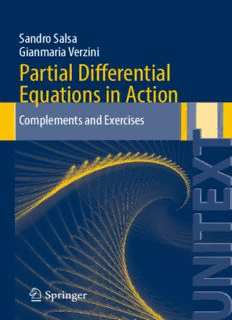
Partial Differential Equations in Action: Complements and Exercises PDF
Preview Partial Differential Equations in Action: Complements and Exercises
Sandro Salsa Gianmaria Verzini Partial Differential Equations in Action Complements and Exercises TT XX EE TT II NN 123 UU UNITEXT – La Matematica per il 3+2 Volume 87 Moreinformationaboutthisseriesat http://www.springer.com/series/5418 (cid:2) Sandro Salsa Gianmaria Verzini Partial Differential Equations in Action Complements and Exercises SandroSalsa GianmariaVerzini DipartimentodiMatematica DipartimentodiMatematica PolitecnicodiMilano PolitecnicodiMilano Milano,Italy Milano,Italy TranslatedbySimonG.Chiossi,UFBA–UniversidadeFederaldaBahia,Salvador(Brazil). TranslationfromtheItalianlanguageedition:Equazioniaderivateparziali.Complementiedesercizi, SandroSalsaeGianmariaVerzini,©Springer-VerlagItalia,Milano2005.Allrightsreserved. UNITEXT–LaMatematicaperil3+2 ISBN978-3-319-15415-2 ISBN978-3-319-15416-9(eBook) DOI10.1007/978-3-319-15416-9 SpringerChamHeidelbergNewYorkDordrechtLondon LibraryofCongressControlNumber:2015930285 ©SpringerInternationalPublishingSwitzerland2015 Thisworkissubjecttocopyright.AllrightsarereservedbythePublisher,whetherthewholeorpartofthe materialisconcerned,specificallytherightsoftranslation,reprinting,reuseofillustrations,recitation,broad- casting,reproductiononmicrofilmsorinanyotherphysicalway,andtransmissionorinformationstorage andretrieval,electronicadaptation,computersoftware,orbysimilarordissimilarmethodologynowknown orhereafterdeveloped. Theuseofgeneraldescriptivenames,registerednames,trademarks,servicemarks,etc.inthispublication doesnotimply,evenintheabsenceofaspecificstatement,thatsuchnamesareexemptfromtherelevant protectivelawsandregulationsandthereforefreeforgeneraluse. Thepublisher,theauthorsandtheeditorsaresafetoassumethattheadviceandinformationinthisbook arebelievedtobetrueandaccurateatthedateofpublication.Neitherthepublishernortheauthorsorthe editorsgiveawarranty,expressorimplied,withrespecttothematerialcontainedhereinorforanyerrorsor omissionsthatmayhavebeenmade. CoverDesign:SimonaColombo,GiochidiGrafica,Milano,Italy TypesettingwithLATEX:PTP-Berlin,ProtagoTEX-ProductionGmbH,Germany(www.ptp-berlin.eu) SpringerisapartofSpringerScience+BusinessMedia(www.springer.com) Preface Thisbookisdesignedforadvancedundergraduatestudentsfromvariousdisciplines,in- cludingappliedmathematics,physics,andengineering.ItevolvedduringthePDEcourses thatbothauthorshavetaughtduringrecentdecadesatthePolitecnicodiMilano,andcon- sistsofproblemsofvarioustypesanddifficulties. Inthefirstpartofthebook,whilemuchemphasisisplacedonthemostcommonmeth- odsofresolution,suchasseparationofvariablesorthemethodofcharacteristics,wealso invitethestudenttohandlethebasictheoreticaltoolsandpropertiesofthesolutionstothe fundamentalequationsofmathematicalphysics. The second part is slightly more advanced and requires basic tools from functional analysis. A small number of exercises aims to familiarize the student with the first ele- mentsofthetheoryofdistributionsandoftheHilbertianSobolevspaces.Thefocusthen switchestothevariationalformulationofthemostcommonboundaryvalueproblemsfor uniformlyellipticequations.Asubstantialnumberofproblemsisdevotedtotheuseofthe Riesz representation and the Lax-Milgram theorems together with Fredholm alternative toanalysewellposednessorsolvabilityofthoseproblems.Next,anumberofproblems addresses theanalysis ofweaksolutionstoinitial-boundary valueproblemsfortheheat orthewaveequation. Thetextiscompletedbytwoshortappendixes,thefirstdealingwithSturm-Liouville problemsandBesselfunctionsandthesecondlistingfrequentlyusedformulas. Eachchapterbeginswithabriefreviewofthemaintheoreticalconceptsandtoolsthat constitutenecessaryprerequisitesforaproperunderstanding.ThetextPartialDifferential EquationinAction[18],byS.Salsa,isthenaturaltheoreticalreference. Within each chapter, the problems are divided into two sections. In the first one we present detailed solutions and comments to provide the student with a reasonably com- pleteguide.Inthesecondsection,weproposeasetofproblemsthateachstudentshould trytosolvebyhim-orherself.Ineachcase,asolutioncanbefoundattheendofthechap- ter.Someproblemsareproposedastheoreticalcomplementsandmayproveparticularly challenging;thisisespeciallytrueofthosemarkedwithoneortwoasterisks. Milano,January2015 SandroSalsa GianmariaVerzini Contents 1 Diffusion ........................................................... 1 1.1 Backgrounds ................................................... 1 1.2 SolvedProblems ................................................ 3 1.2.1 Themethodofseparationofvariables........................ 3 1.2.2 Useofthemaximumprinciple .............................. 20 1.2.3 Applyingthenotionoffundamentalsolution .................. 25 1.2.4 UseofFourierandLaplacetransforms ....................... 37 1.2.5 Problemsindimensionhigherthanone....................... 43 1.3 FurtherExercises................................................ 50 1.3.1 Solutions ................................................ 56 2 TheLaplaceEquation ............................................... 81 2.1 Backgrounds ................................................... 81 2.2 SolvedProblems ................................................ 84 2.2.1 Generalpropertiesofharmonicfunctions ..................... 84 2.2.2 Boundary-valueproblems.Solutionmethods .................. 95 2.2.3 PotentialsandGreenfunctions ..............................117 2.3 FurtherExercises................................................124 2.3.1 Solutions ................................................130 3 FirstOrderEquations ...............................................149 3.1 Backgrounds ...................................................149 3.2 SolvedProblems ................................................152 3.2.1 Conservationlawsandapplications ..........................152 3.2.2 Characteristicsforlinearandquasilinearequations .............181 3.3 FurtherExercises................................................194 3.3.1 Solutions ................................................197 4 Waves .............................................................215 4.1 Backgrounds ...................................................215 4.2 SolvedProblems ................................................217 viii Contents 4.2.1 One-dimensionalwavesandvibrations .......................217 4.2.2 Canonicalforms.CauchyandGoursatproblems ...............238 4.2.3 Higher-dimensionalproblems...............................247 4.3 FurtherExercises................................................255 4.3.1 Solutions ................................................259 5 FunctionalAnalysis .................................................273 5.1 Backgrounds ...................................................273 5.2 SolvedProblems ................................................278 5.2.1 Hilbertspaces ............................................278 5.2.2 Distributions .............................................291 5.2.3 Sobolevspaces ...........................................298 5.3 FurtherExercises................................................310 5.3.1 Solutions ................................................314 6 VariationalFormulations ............................................333 6.1 Backgrounds ...................................................333 6.2 SolvedProblems ................................................336 6.2.1 One-dimensionalproblems .................................336 6.2.2 Ellipticproblems .........................................346 6.2.3 Evolutionproblems .......................................366 6.3 FurtherExercises................................................381 6.3.1 Solutions ................................................385 AppendixA.Sturm-Liouville,LegendreandBesselEquations................405 A.1 Sturm-LiouvilleEquations........................................405 A.1.1 Regularequations.........................................405 A.1.2 Legendre’sequation.......................................406 A.2 Bessel’sEquationandFunctions...................................407 A.2.1 Besselfunctions ..........................................407 A.2.2 Bessel’sequation .........................................410 AppendixB.Identities ...................................................413 B.1 Gradient,Divergence,Curl,Laplacian ..............................413 B.2 Formulas ......................................................415 B.3 FourierTransforms ..............................................416 B.4 LaplaceTransforms..............................................417 References..............................................................419 1 Diffusion 1.1 Backgrounds Weshallrecallafewnotionsandresultsthatcropupfrequentlyconcerningthediffusion equation u (cid:3)D(cid:2)uDf t definedonacylindricaldomainQ D(cid:3)(cid:4).0;T/,where(cid:3)isadomain(connected,open T subset)ofRn.Hereu D u.x;t/,andtheLaplacian(cid:2)istakenwithrespecttothespatial variablesxonly. •Parabolicboundary.TheunionofthebaseofQ (i.e.(cid:3)(cid:4)¹0º)andthelateralsur- T faceS D@(cid:3)(cid:4)Œ0;T(cid:4)istheparabolicboundaryof Q ,whichwedenoteby@ Q .In T T p T well-posedproblemsforthediffusionequationthisiswhereonemustassignthedata. (cid:2) (cid:3) •Maximumprinciples.Let(cid:3)beboundedandw 2C2;1.Q /\C Q asub-solution T T (orsuper-solution),thatis w (cid:3)D(cid:2)w Dq (cid:5)0 (resp. (cid:6)0) inQ : t T Then w reaches its maximum value (resp. minimum) on the parabolic boundary @ Q p T ofQ : T maxw D max w QT @pQT (weakmaximumprinciple).Inparticular,ifw isnegative(resp.positive)on@ Q ,then p T itisnegative(resp.positive)overallofQ .If,further,w.x ;t /Dmax withx 2(cid:3); thenwisconstanton(cid:3)(cid:4)Œ0;t (cid:4)(strongmTaximumprincipl0e).0 QT 0 0 •FundamentalsolutionandglobalCauchyproblem.Thefunction (cid:5) .x;t/D 1 e(cid:2)jxj2=.4Dt/; t >0; D .4(cid:6)Dt/n=2 is called fundamental solution to the diffusion equation; when t > 0 it solves ©SpringerInternationalPublishingSwitzerland2015 S.Salsa,G.Verzini,PartialDifferentialEquationsinAction.ComplementsandExercises, UNITEXT–LaMatematicaperil3+287,DOI10.1007/978-3-319-15416-9_1 2 1 Diffusion u (cid:3)D(cid:2)uD0andistheuniquefunctionsatisfying t Z lim(cid:5) .x;t/Dı .x/; (cid:5) .x;t/dxD1foranyt >0; D n D t#0 Rn whereı .x/denotesthen-dimensionalDirac’sdeltafunction. n ThefundamentalsolutionenablestoconstructthegeneralsolutiontotheglobalCauchy problem ´ u (cid:3)D(cid:2)uDf .x;t/ inRn(cid:4).0;1/ t u.x;0/Dg.x/ inRn; bymeansoftheformula Z Z Z t u.x;t/D (cid:5) .x(cid:3)y;t/g.y/ dyC (cid:5).x(cid:3)y;t (cid:3)s/f .y;s/ dyds: D Rn 0 Rn Thelatterholds,forexample,whenjg.x/j(cid:5)ceAjxj,f isboundedandf,f ,f ,f t xj xixj arecontinuousonRn(cid:4).0;C1/.Atapointx ofcontinuityofgwehave 0 u.x;t/!g.x / as .y;t/!.x ;0/,t >0: 0 0 •Random walkand fundamental solution (n D 1).Letusconsideraparticleofunit massmovingalongthex-axisasfollows. i) Inatimeinterval(cid:7) theparticleadvancesbyh,startingfromx D0. ii) Itmovesleftwardsorrightwardswithprobabilityp D 1=2,eachtimeindependently ofthepreviousaction. At time t D N(cid:7), i.e. after N iterations, the particle will have reached point x D mh, whereN isanaturalnumberandmaninteger.Theprobabilityp.x;t/thatitwillbeinx attimet isthesolutionofthediscreteproblem 1 1 p.x;t C(cid:7)/D p.x(cid:3)h;t/C p.xCh;t/; (1.1) 2 2 withinitialconditions p.0;0/D1andp.x;0/D0 ifx ¤0: Passing to the limit in (1.1) for h;(cid:7) ! 0, whilst keeping h2=(cid:7) D 2D D constant and interpreting p as a probability density, gives the equation p D Dp , and the initial t xx conditionsnowread limp.x;t/Dı .ı Dı/: 1 t#0 Wehavealreadynoticedthattheuniquesolutionwithunitmassisthefundamentalsolu- tiontothediffusionequation: p.x;t/D(cid:5) .x;t/: D
Description: